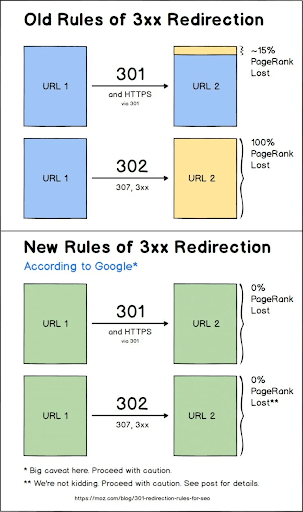If you’ve ever changed your mailing address from one location to another, you already know how important it is to redirect all the mail that goes out to your old address! If you move away from your old address, you could revisit it frequently to get the mail you missed – but you can’t do this forever! In the online world, things are vastly different and much harder. If you move a web page or a post to a different URL, other people can’t reach that article.
Missing out on traffic to your old website URL could be disastrous for your brand and disappoint your customers.
Imagine you’ve got an eCommerce store selling Christmas trees and recently moved your website address to another URL. If all the traffic goes to the old website address and clients get a 404 error code, you would miss out on potential sales, which can be especially devastating for a seasonal product!
A 301 redirect is the equivalent of a mail redirect service for website URLs. It’s the best kind of redirect when you’re moving your website address permanently, unlike the 302 or 511 redirects, which are more useful for a temporary redirect.
If you’ve been planning to understand 301 redirects better, you’ve come to the right place. Find out what they are, why you should use them, and how you can implement them as a source of traffic for your site. 21
So, if you’re ready, let’s begin!
- What is a 301 Redirect?
- Do 301 Redirects Affect SEO?
- Why Use a 301 Redirect?
- How to Use or Create a 301 Redirect
- Other Redirect Types
What is a 301 Redirect?
A 301 redirect is a permanent redirect instruction that leads website traffic to your desired URL. It’s an HTTP status code easily interpreted and implemented by search engine bots, so it’s in the SEO best practices of changing a website URL.
The great thing about 301 redirect is that it helps carry forward all the link weighting and ranking authority your original URL would’ve gathered over time to the new page. This way, you won’t lose the previous SEO efforts you might’ve put in to enhance your search rankings.A 301 redirect is an all-inclusive instruction to search engines that indicates that the website URL and all the pages have moved permanently to another online location. The critical word here is permanent.

Do 301 Redirects Affect SEO?
The greatest thing we’ve covered so far is that 301 redirects aim to inform search engines about the content’s new URL carrying all the SEO information with them. This immediately means that 301 redirects affect SEO in some ways.
Most SEO experts focus on linking 301 to PageRank 301 redirects. The 301 redirect preserves the SEO rankings of the web page, passes on the link juice, and helps maintain the domain authority. Use 301 redirects whenever you make URL changes, as it helps keep the website’s SEO intact.
Although 301 redirects would lead to a minor dip in rankings, this penalty was removed from Google in mid-2016. This was because search engines needed time to recognize and process the 301 redirects. So ultimately, 301 redirects affect SEO, but the effect is primarily positive.

Why Use a 301 Redirect?
Here are a few situations where you may want to use a 301 redirect:
- If you’ve reorganized or overhauled your website and changed its location permanently.
- If your content expires and you wish to redirect users to a new location.
- If you’re merging or have merged two websites into one new website URL.
- If you’ve changed your website’s CMS or are migrating your site to WordPress.
All of the above scenarios require you to redirect incoming website traffic to a new location, the right location, so your website visitors can get to you.
Another solid reason to use 301 redirects is that they preserve up to 90-99% of your search ranking power. Any social shares, backlinks, and references that helped your old URL get a better ranking will be transferred to the new URL ranking.
A 301 redirect is also a status code instruction easily understood by Google. It supports indexing the new website and all of its new pages faster and more efficiently. Other redirects may not be as easily crawled or interpreted by search engines, so 301s are the best to use.

How to Use or Create a 301 Redirect
It might take time for search engines to detect that you’ve implemented a 301 redirect and changed your website URL location. We advise you to implement it at the right time, so you don’t miss out on any incoming traffic. You must also ensure you implement a 301 redirect instruction accurately to prevent technical glitches.
There are a few ways to implement a 301 redirect:

1. Redirect by editing the .htaccess file (mod_rewrite)
The .htaccess file is a configuration file used by web servers running the Apache Web Server software. It provides a way to make configuration changes on a per-directory basis. The .htaccess file is placed inside the web tree and can override a subset of the server’s global configuration for the directory it’s in and all sub-directories. Typical uses of .htaccess files include URL rewriting, password protection, and blocking specific IP addresses.
You can do this by accessing a command called “Allow Override” within the Apache Config File. Once you’re in the root folder, you can edit the code using a UNIX-style text editor.
You’ll need to open your FTP and log into your website server or hosting admin panel for a successful implementation. Try to work your way into the .htaccess file in your root folders. Usually, the .htaccess file is hidden, so make sure you enable your browser to view hidden files to see .htaccess on the list.
The instruction codes you’d use under this method would be the following:
- Permanent redirect of a single page:
RedirectPermanent/old-file.html/https://www.domain.com/new-file.hml
- Permanent redirect of an entire domain:
RedirectPermanent/https://new-domain.com/
Your server reads your 301 redirect code instruction line by line, so it’s best to put a blank line at the end of your code to indicate the closure of your instruction. As a last resort, if you can’t access the “.htaccess” file, you can always call your hosting provider to seek help.
2. Using a Free WordPress Plugin
Several plugins make it easy to implement 301 redirects, particularly if you’re using the WordPress CMS. We recommend you use Yoast’s WordPress plugin to set up redirects. It’s a safe way to go, as several developers use, test, and trust it.
Some other plugins you could use are:
This is an ‘easy redirect manager’ that helps you create both 301 and 302 redirects easily.
It’s an open-source tool that works like a charm.
3. Redirection
A simple-to-use, comprehensive redirection plugin that helps you keep track of all 404 errors, tie up loose ends in your site, and set up 301 redirects with ease.
It’s always good to spend some time testing your website once you’re done with setting up the redirect. You’ll want to ensure the redirect instruction works smoothly and leads you to the correct URL.
Get some people to visit your website soon after implementing it. Ensure it’s working well and that it can handle large website traffic volumes to create an efficient and smooth customer journey.

Other Redirect Types
Apart from the 301 redirects we talked about, there are plenty of other ways to redirect your visitors to the correct pages. Since we discussed the permanent redirects in this article, it’s time to see all web developers’ other options at their disposal.
Meta refresh redirects
Meta refresh redirects are website redirects that use a meta tag to tell a web browser to refresh the page and automatically redirect to a different URL. These redirects are often used when a website is moved to a new domain or when a web page is no longer available.
Meta refresh redirects are often used in website development to ensure visitors are directed to the correct page. They can also be used to create a better user experience by redirecting visitors to the most relevant page.
Meta refresh redirects do not help with SEO. They are not seen as a form of link building, and search engines won’t give any SEO benefit to websites that use them. However, they can help with user experience, which can indirectly help with SEO.
JavaScript redirects
JavaScript redirects are website redirects that use JavaScript code to redirect visitors to a different URL. They also create a delay before redirecting to a new page.
JavaScript redirects are a vital part of redirecting a page online, but it’s not guaranteed that the Google search engine bot will interpret it as a 301; thus, it’s not a recommended method.
The following code snippet is for JavaScript redirects:
<script type=”text/javascript”> function redirect1(){ window.location = “https://www.example.com/new-url/” } setTimeout(‘redirect1()’, 5000); </script>
This JavaScript redirect code can help keep your SEO intact, and search engines will render the JavaScript redirect code, and continue by redirecting to the new path.
PHP redirects
Another way of redirecting visitors to a new page is with the help of PHP by adding a code snippet at the HTML header. They can also create a better user experience by redirecting visitors to the most relevant page, which is within the SEO best practices.
A PHP example is this:
<?php
header(“Location: https://www.example.com/”, true, 301);
exit();
?>
PHP redirects can help with your SEO efforts. Just like the JavaScript redirect, search engines will recognize that the page is being redirected and won’t harm your SEO in any way.
Conclusion: 301 Redirects Are the Way to Go
It’s no surprise that the HTTP status code 301 is the best way of setting up a permanent redirect to a new website URL. They maintain your domain authority, a great way to ensure that users are directed to the most up-to-date website version.
301 redirects have been used for ages and are trusted by everyone in the online marketing and developer community. Although some implementations are a bit tricky, like editing the .htaccess file, they’re generally safe to deploy.
However, if you own a WordPress website, it’s even easier with the help of all the available plugins, like the ones we discussed. Some, for example, YoastSEO, will also fiddle around with the .htaccess file, making the process easier for inexperienced users.
Let us know how your first 301 redirects went, and make sure to reach out to the PapaSquad if you need any help!




